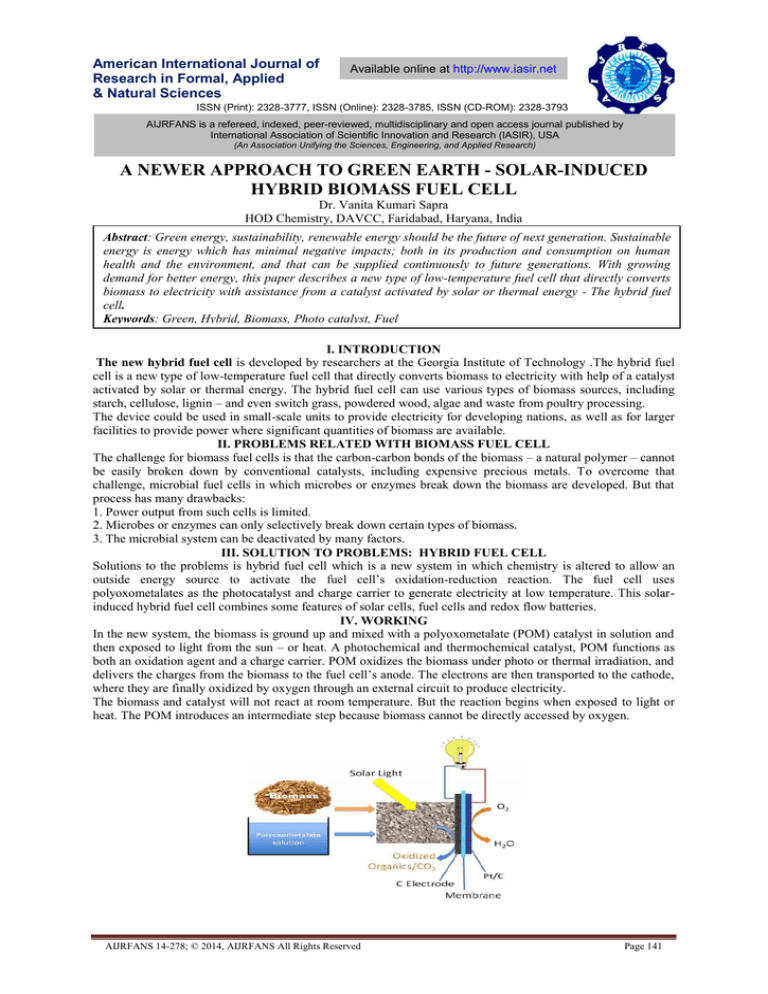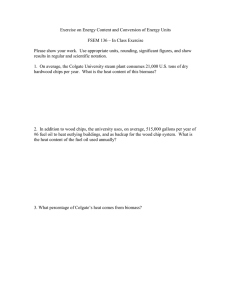
American International Journal of
Research in Formal, Applied
& Natural Sciences
Available online at http://www.iasir.net
ISSN (Print): 2328-3777, ISSN (Online): 2328-3785, ISSN (CD-ROM): 2328-3793
AIJRFANS is a refereed, indexed, peer-reviewed, multidisciplinary and open access journal published by
International Association of Scientific Innovation and Research (IASIR), USA
(An Association Unifying the Sciences, Engineering, and Applied Research)
A NEWER APPROACH TO GREEN EARTH - SOLAR-INDUCED
HYBRID BIOMASS FUEL CELL
Dr. Vanita Kumari Sapra
HOD Chemistry, DAVCC, Faridabad, Haryana, India
Abstract: Green energy, sustainability, renewable energy should be the future of next generation. Sustainable
energy is energy which has minimal negative impacts; both in its production and consumption on human
health and the environment, and that can be supplied continuously to future generations. With growing
demand for better energy, this paper describes a new type of low-temperature fuel cell that directly converts
biomass to electricity with assistance from a catalyst activated by solar or thermal energy - The hybrid fuel
cell.
Keywords: Green, Hybrid, Biomass, Photo catalyst, Fuel
I. INTRODUCTION
The new hybrid fuel cell is developed by researchers at the Georgia Institute of Technology .The hybrid fuel
cell is a new type of low-temperature fuel cell that directly converts biomass to electricity with help of a catalyst
activated by solar or thermal energy. The hybrid fuel cell can use various types of biomass sources, including
starch, cellulose, lignin – and even switch grass, powdered wood, algae and waste from poultry processing.
The device could be used in small-scale units to provide electricity for developing nations, as well as for larger
facilities to provide power where significant quantities of biomass are available.
II. PROBLEMS RELATED WITH BIOMASS FUEL CELL
The challenge for biomass fuel cells is that the carbon-carbon bonds of the biomass – a natural polymer – cannot
be easily broken down by conventional catalysts, including expensive precious metals. To overcome that
challenge, microbial fuel cells in which microbes or enzymes break down the biomass are developed. But that
process has many drawbacks:
1. Power output from such cells is limited.
2. Microbes or enzymes can only selectively break down certain types of biomass.
3. The microbial system can be deactivated by many factors.
III. SOLUTION TO PROBLEMS: HYBRID FUEL CELL
Solutions to the problems is hybrid fuel cell which is a new system in which chemistry is altered to allow an
outside energy source to activate the fuel cell’s oxidation-reduction reaction. The fuel cell uses
polyoxometalates as the photocatalyst and charge carrier to generate electricity at low temperature. This solarinduced hybrid fuel cell combines some features of solar cells, fuel cells and redox flow batteries.
IV. WORKING
In the new system, the biomass is ground up and mixed with a polyoxometalate (POM) catalyst in solution and
then exposed to light from the sun – or heat. A photochemical and thermochemical catalyst, POM functions as
both an oxidation agent and a charge carrier. POM oxidizes the biomass under photo or thermal irradiation, and
delivers the charges from the biomass to the fuel cell’s anode. The electrons are then transported to the cathode,
where they are finally oxidized by oxygen through an external circuit to produce electricity.
The biomass and catalyst will not react at room temperature. But the reaction begins when exposed to light or
heat. The POM introduces an intermediate step because biomass cannot be directly accessed by oxygen.
AIJRFANS 14-278; © 2014, AIJRFANS All Rights Reserved
Page 141
Vanita Kumari Sapra, American International Journal of Research in Formal, Applied & Natural Sciences, 6(2), March-May 2014, pp141142
IV. WORKING OF HYBRID FUEL CELL
A. POWER GENERATED
The power density of the solar-induced hybrid fuel cell powered by cellulose reaches 0.72 mW cm−2, which is
almost 100 times higher than cellulose-based microbial fuel cells and is close to that of the best microbial fuel
cells reported in literature.
ADVANTAGES
1.
The system gives major advantages, including combining the photochemical and solar-thermal biomass
degradation in a single chemical process, leading to high solar conversion and effective biomass
degradation.
2.
It also does not use expensive noble metals as anode catalysts because the fuel oxidation reactions are
catalyzed by the POM in solution.
3.
The hybrid fuel cell can use unpurified polymeric biomass without concern for poisoning noble metal
anodes because the POM is chemically stable.
4.
Unlike most cell technologies that are sensitive to impurities, the cell reported in this study is inert to
most organic and inorganic contaminants present in the fuels.
5.
The system can use soluble biomass, or organic materials suspended in a liquid. In experiments, the
fuel cell operated for as long as 20 hours, indicating that the POM catalyst can be re-used without
further treatment.
6.
Beyond the ability to directly use biomass as a fuel, the new cell also offers advantages in sustainability
– and potentially lower cost compared to other fuel cell types.
V. FUTURE PROSPECTIVE
This system can be optimized by having a better understanding of the chemical processes involved and its
improvement. Then this type of fuel cell could have an energy output similar to that of methanol fuel cells in the
future.
VI. CONCULSION
Sustainable materials can be used without any chemical pollution. Solar energy and biomass are two important
sustainable energy sources available to the world today. This system would use them together to produce
electricity while reducing dependence on fossil fuels. Thus, the new HYBRID FUEL CELL is an amazing and
beneficial innovation for future.
REFERENCES
[1].
[2].
[3].
[4].
Rühl, C., Appleby, P., Fennema, J., Naumov, A. & Schaffer, M. Economic development and the demand for energy: a historical
perspective on the next 20 years
Tollefson, J. & Monastersky, R. The global energy challenge: Awash with carbon
Deng, W., Zhang, Q. & Wang, Y. Polyoxometalates as efficient catalysts for transformations of cellulose into platform
chemicals. Dalton Transact
.Article in the journal Nature Communications
AIJRFANS 14-278; © 2014, AIJRFANS All Rights Reserved
Page 142


